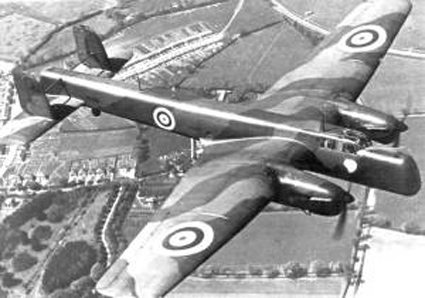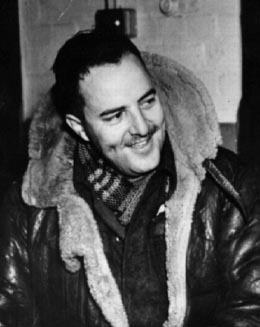Whitley N1485 damaged by flak, returned to Dishforth airfield.
On the night 12th / 13th August 1940 this 78 Squadron crew were tasked with bombing industrial targets in the Ruhr valley and took off from Dishforth at 20.35hrs. The aircraft sustained minor flak damage to the tail but the
crew were able to land safely at Dishforth at 05.15hrs on 13th August 1940 where it was soon repaired.
Pilot - F/O David Robertson RAF (40141).
Pilot - P/O Michael Lomax Stedman RAF (36263).
Observer - Sgt Robert Victor Collinge RAF (581204).
Wireless Operator / Air Gunner - Sgt Thomas William Donoghue RAF (620537).
Air Gunner - Sgt H Hawkesley
Stewart Robertson was born Ogema, Saskatchewan, Canada but his family moved to Calgary when he was young and this was where he went to school. He worked for the Royal Bank of Canada for nearly two years before leaving for England and being accepted into the RAF at the end of May 1937. He began training at 2 FTS on 12th July 1937 flying a Blackburn B2 solo in eleven days, he left there on 4th September 1937 to continued his training and was awarded his Wings on 3rd January 1938. Prior to the war he is reported to have flown a number of aircraft in differing roles gaining flying experience. He would eventually solo the Whitley for the first time on 24th February 1940. He force-landed one in March 1940 at Upavon but its identity is yet to be discovered. He was posted to 10 OTU in April 1940 and completed his training. He was then posted to "B" Flight, at 51 Squadron on 20th May 1940 and flew his first Operational flight on 24th May 1940 acting as second pilot to S/Ldr Richard Wildey and in the next twenty seven days they completed thirteen operational flights. On 17th June his aircraft suffered engine trouble on return from Gelsenkirchen, he was able to return to base on one engine. One flight was to Turin, using the Channel Islands as a forward landing ground, the aircraft's port engine iced up before crossing the Alps so he returned early. Following these flights with 51 Squadron he was given three weeks leave and he and his then crew transferred to 78 Squadron at Dishforth on 19th July 1940.
His first flight with 78 Squadron was on the night he arrived at the squadron, his aircraft was attacked by two fighters and heavy AA fire was reported (this may have been in the incident recorded above). He completed a further twenty five operational flights with 78 Squadron and thus completed a Tour. He was later awarded a DFC for "gallantry and devotion to duty in the execution of air operations" the recommendation also stated that "this officer has completed 29 operational flights over enemy territory at night. In all circumstances he has exhibited a high degree of resolution and skill. His determined and cheerful demeanour have set a valuable example to other members of the squadron." His DFC was presented by King George VI on 8th February 1941.
In late November 1940 he was posted to 10 OTU at Abington and training to be an instructor at 24 CAOS at Moffat, Rhodesia. Whilst stationed here
he married in November 1941. He returned to England in October 1942 as a Squadron Leader, he commanded "B" Flight of 149 Squadron at Lakenheath flying
Stirlings where he completed his second Tour and was posted to 81 OTU at Tilstock in March 1943, having completed 44 operational flights.
Now a W/C, he was involved in an accident on 26th August 1943. He was in the control tower at Steap, a satellite airfield of Tilstock,
when Whitley HF628 crashed into it, two on the aircraft were killed and he and five others were injured. A re-organisation of the
RAF would then see 81 OTU transfer to 38 Group leading up to the D-Day landings. He took command of the Unit and saw out the War in this role and
would later return home to Canada.
On 19th March 1948 he joined 403 RCAF Reserve Squadron until December the following year when he made his final flight in a Mustang. He had flown
19 different types of aircraft and had amassed 1887 hours flying time.


Whitley N1485 was built to contract 75147/388 by Armstrong Whitworth Ltd. at Baginton and was allotted to 6 MU on 2nd January 1940. The aircraft was then received by 6 MU on 24th February 1940 and after preparation for operational flying was taken on charge by 51 Squadron at Dishforth on 14th May 1940. On 29th May 1940 the aircraft transferred to 78 Squadron at Linton on Ouse and they then moved to Dishforth on 15th July 1940. On 13th August 1940 it was slightly damaged on flak. Cat.M/FB damage would have been the damage assessment but there is no mention of this on the aircraft's AM Form 78. It would have been repaired on site and returned to the unit later in the month. On 14th December 1940 it failed to return from Ops to Kiel when it was abandoned on return trip over The Wash with three being killed and two being rescued. Cat.W/FB damage was recorded on the paperwork and it was struck off charge.